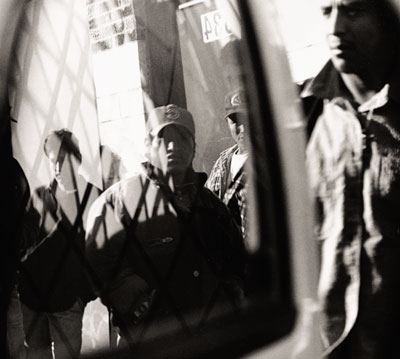
Image: Jon Lowenstein
In Chicago, as across America, Mexican day laborers struggle to navigate an underground economy.
|
{publish-page-break}
|
|
|
{publish-page-break}
The building owner refused to pay the contractor, so the contractor refused to pay the day laborers, including Antonio Velazquez, who complains to police. Velazquez says living in the United States is difficult and he often feels like “doing something crazy.”
|
|
|
{publish-page-break}
Angelo Ojeda was promised $60 to dig this ditch but worries that the contractor won’t pay him.
|
|
|
Frustration boils over after a worker is offered less than minimum wage.
|
|
|
Exhausted from long days in a Chicago factory, a Mexican woman counts out the $4,500 her family is sending a “coyote” to smuggle three relatives across the border to Phoenix.
|
|
|
A family meets relatives at Midway airport. They will now be ushered into a life as jornaleros.
|
 |
||||
| |
Roofing, painting, wiring, plumbing, laying carpet, building a house; weeding, planting, watering, pruning, digging a ditch; moving boxes and removing asbestos; working in a soap factory, a sweatshop, a meatpacking plant; washing dishes, flipping burgers, sweeping the floor — when you’re a day laborer, you never know what a day’s work will be. It could be 12 hours of construction work for $100, four hours of yardwork at minimum wage, or no work at all. Early in the morning, los jornaleros, Mexican slang for “day laborers,” stand on sidewalks and at busy intersections, outside paint stores and Home Depots, waiting. When a van or a pickup appears, they rush toward it, surround it, declaring their skills in broken English. A few get hired, climb in, and drive off. The rest wait for the next one. Day labor is work at its most elemental: no benefits, no job security, no overtime, and payment in cash. The employers get cheap labor, tax-free. And the workers get work. Until recently los jornaleros were a common sight only in California and the Southwest. Today, you can find them at the intersection of Lawrence and Springfield in northwest Chicago (right) — which is known as la parada (“the stop”) — and on street corners across the United States. They have become the urban and suburban equivalent of migrant farm-workers. In his writings on day laborers, UCLA professor Abel Valenzuela Jr. offers a portrait of working life at the bottom. Day laborers are overwhelmingly male and Latino (though Latinas can find day work in factories or as domestics). One survey found that more than 80 percent are illegal immigrants and more than half never made it past sixth grade. Most speak little English. Their marginal legal status and lack of education make them vulnerable to unscrupulous smugglers, landlords, and employers. Sometimes day laborers work all day but never get paid. Or they get paid less than what was promised. They handle toxic materials without proper safety equipment, perform dangerous work without health insurance, suffer injuries on the job, and then get fired. Anti-immigrant groups blame them for all kinds of social problems. More than 30 cities and towns have passed laws to keep day laborers off the streets. But the new laws rarely target the contractors, home owners, and factory managers who profit most from this unregulated, illegal work. In Chicago, many jornaleros find jobs through the temporary employment agencies that have sprung up in Latino neighborhoods on the city’s West and South sides, as well as in suburban towns such as Villa Park, West Chicago, and Bensenville. Such private firms give day labor a rudimentary structure, maintaining relationships with employers, requiring Social Security numbers from workers (authentic or not), paying wages by check, and charging workers for these services (see “Street Corner, Incorporated,” March/April). Most of the agencies are legitimate, but some rip off day laborers as efficiently as any crooked employer. The jobs they provide are often located in the factories and industrial parks where Chicago’s stockyards once stood. In the neighborhood known as Back of the Yards, in the same small houses where Eastern European meatpackers lived for generations, Mexican day laborers now sleep half a dozen to a room. Activists across the country recently formed the National Day Labor Organizing Network. And church groups and nonprofits have opened about 75 day-labor centers that offer a variety of services to poor immigrant workers. But most of America’s jornaleros must look after themselves. The one trait that their job requires, more than any other, is self-reliance. They come to the United States at great risk, operate outside any formal hierarchy, rely solely on their own skills, work hard, send money home, save money to bring relatives north, and usually succeed at raising the income of their families. They possess the very qualities that our business schools celebrate. The great irony of day laborers is that they embody the American dream, yet are widely used, abused, and despised. Some of the strongest animosity is felt by the workers whom they displace. The nation’s poor are now being forced to compete with the even poorer. It’s the latest chapter of an old story, unfolding on a street corner near you.
|
|
||
|
|
||||
| |
|
|
||


















